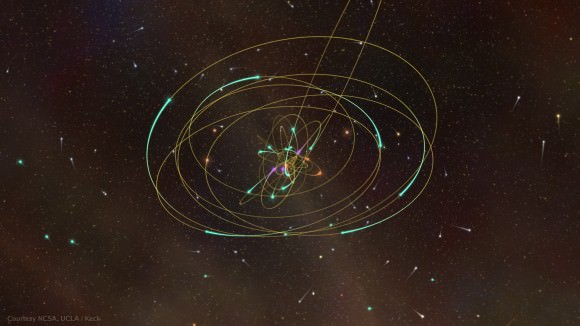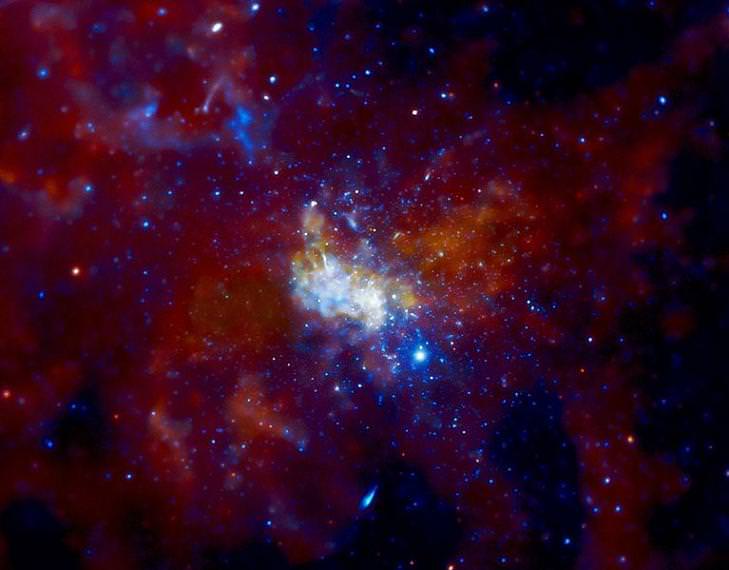Deep in the heart of the Milky Way resides a black hole. However, that is not the mysterious object which scientists Fabio Antonini, of the Canadian Institute for Theoretical Astrophysics, and David Merritt, of the Rochester Institute of Technology, have been endeavoring to explain. The objects of their attention are the orbits of massive young stars which attend it. They are called “S-stars”.
No. That’s not a stutter. S-Stars are a legitimate phenomenon which enable researchers to even more closely examine black hole activity. Their very presence causes astronomers to question what they know. For example, how is it possible for these massive young stars to orbit so close to a region where it would be highly unlikely for them to form there? The sheer force of the strong gravity near a black hole means these stars had to have once been further away from their observed position. However, when theoreticians created models to depict how S-stars might have traveled to their current orbital positions, the numbers simply didn’t match up. How could their orbits be so radically removed from predictions?
Today, Dr. Antonini offered his best explanation of this enigma at the annual meeting of the Canadian Astronomical Society (CASCA). In “The Origin of the S-star Cluster at the Galactic Center,” he gave a unified theory for the origin and dynamics of the S-stars. It hasn’t been an easy task, but Antonini has been able to produce a very viable theory of how these stars were able to get in close proximity to a supermassive black hole in only tens of millions of years since their formation.
“Theories exist for how migration from larger distances has occurred, but have up until now been unable to convincingly explain why the S-stars orbit the galactic center the way they do,” Antonini said. “As main-sequence stars, the S-stars cannot be older than about 100 million years, yet their orbital distribution appears to be ‘relaxed’, contrary to the predictions of models for their origin.”

According to Antonini and Merritt’s model, S-stars began much further away from the galactic center. Normal? Yep. Normal mode. Then these seemingly normal orbiting stars encountered the black hole’s gravity and began their spiral inward. As they made the inexorable trek, they then encountered the gravity of other stars in the vicinity which then changed the S-stars orbital pattern. It’s a simple insight, and one that verifies how the galactic center evolves from the conjoined influence of a supermassive black holes relativistic effects and the handiwork of gravitational interactions.
“Theoretical modeling of S-star orbits is a means to constrain their origin, to probe the dynamical mechanisms of the region near the galactic center and,” says Merritt, “indirectly to learn about the density and number of unseen objects in this region.”
Although the presence of supermassive black holes at the center of nearly all massive galaxies isn’t a new concept, further research into how they take shape and evolve leads to a better understanding of what we see around them. These regions are deeply connected to the very formation of the galaxy where they exist. With the center of our own galaxy – Sagittarius A – so near to home, it has become the perfect laboratory to observe manifestations such as S-stars. Tracking their orbits over an extended period of time has validated the presence of a supermassive black hole and enlightened our thinking of our own galaxy’s many peculiarities.
Original Story Source: Canadian Astronomical Society Press Release


Try working that one out on a slide-rule
This seems to imply physics from the virial theorem. A collection of interacting particles will on average settle into a state where the kinetic energy has a magnitude equal to half the magnitude of the potential energy. This means for a system of particles that initially interact with a range of energy, some of these particles are ejected which carries off kinetic energy. Evaporative cooling is an analogue of this. Consequently I suspect these stars formed further away from the SMBH, but due to the statistics involved with how many body systems interact were “cooled” or lost energy so they ended up near the SMBH.
LC
It is going to be quite a show when one of those stars goes supernova and feeds billions of tons of matter into our SMBH.